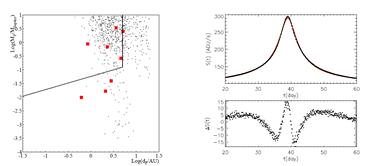[/caption]
Using a technique called Pixel-lensing, a group of astronomers in Italy may have detected a planet orbiting another star. But this planet is unique among the 300-plus exoplanets discovered so far, as it and its parent star are in another galaxy. The Andromeda Galaxy, to be exact. Technically, the star in M31 was found to have a companion about 6 times the mass of Jupiter, so it could be either a brown dwarf or a planet. But either way, this is a remarkable feat, to find an object of that size in another galaxy.
Pixel-lensing, or gravitational microlensing was developed to look for MAssive Compact Halo Objects MACHOs in the galactic halo of the Milky Way. Because light rays are bent when they pass close to a massive object, the gravity of a nearby star focuses the light from a distant star towards Earth. This method is sensitive to finding planets in our own galaxy, ranging is sizes from Jupiter-like planets to Earth-sized ones. And recently, astronomers used gravitational microlensing to be able to see about a dozen or so stars in M31, an extraordinary accomplishment in itself.
The advantage of microlensing is that it works best for more distant objects, therefore in theory it would seem to be ideal for planet hunting in other galaxies. So, the researchers from the National Institute of Nuclear Physics in Italy, led by Gabriele Ingrosso decided to see if this method would work to detect planets orbiting the stars seen in Andromeda. They used a Monte Carlo approach, where they selected the physical parameters of the binary lens system –a star hosting a planet– and calculated the pixel-lensing light curve, taking into account the finite source effects. The team thought they should be able to detect a planet with about 2 Jupiter masses.
The light from one of the stars they studied in Andromeda showed a distinct variability, most likely from a companion, which could be an orbiting planet based on the object’s mass.
One disadvantage to microlensing is that exposures are available for a few days at most, so the team is hoping for another chance to follow up on their discovery.
The team notes in their paper that perhaps an extrasolar planet in M31 might have already been detected since an anomaly in a pixel-lensing light curve was previously reported by another research team in 2004, who claimed that a possible binary system in M31 was responsible for an observed anomaly in an observed light curve.
Source: arXiv, Technology Review Blog


What a treat, thanks Nancy! And the first of many, it seems like. Awesome resolution to boot, the paper mentions 0.1 Earth masses “in principle” possible (albeit with awful statistics).
And this on the same day as “The Extrasolar Planets Encyclopaedia” ticked up to ~ 400 exoplanets found (i.e. 353). I feel decidedly “extra” special today.
“Technically, the star in M31 was found to have a companion about 6 times the mass of Jupiter, so it could be either a brown dwarf or a planet.”
That threw me for a while, though. Seems the IAU “Working Group on Extrasolar Planets” have issued a position statement (2001) to the effect that:
“[…] subject to change as we learn more about the census of low-mass companions, the WGESP has agreed to the following statements:
1) Objects with true masses below the limiting mass for thermonuclear fusion of deuterium (currently calculated to be 13 Jupiter masses for objects of solar metallicity) that orbit stars or stellar remnants are “planets” (no matter how they formed). The minimum mass/size required for an extrasolar object to be considered a planet should be the same as that used in our Solar System.
2) Substellar objects with true masses above the limiting mass for thermonuclear fusion of deuterium are “brown dwarfs”, no matter how they formed nor where they are located.”
So presumably IAU would consider the proposed discovery as such as a “planet”, which was as I remembered it.
Wow – that is an impressive feat if it bears up.
Phfff – extrasolar planet hunting is so early 2000’s. Now it’s all about extragalactic planets!
Hey, doesn’t EU/PU say that gravitational lensing is bunk? That’s some useful bunk right there.
If this is confirmed, I think that Gabriele Ingrosso and her coleagues definitely deserve a Nobel Prize!
This is so amazing.